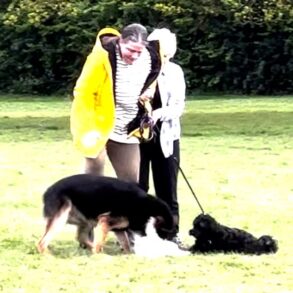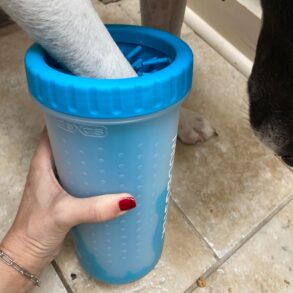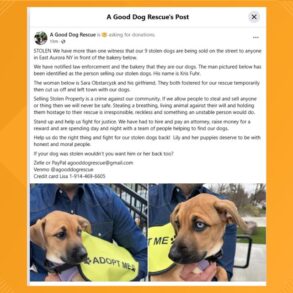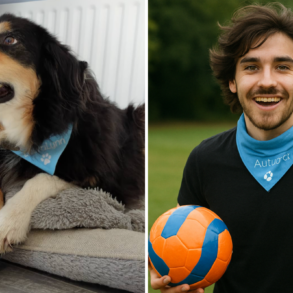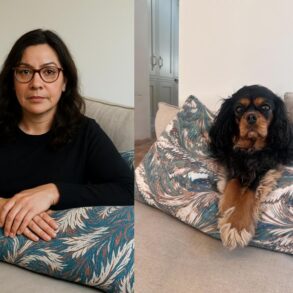We all want our dogs to live long, healthy lives. We would do anything to make that possible. The Dog Aging Project represents a groundbreaking initiative aimed at understanding the aging process in dogs and improving their health and longevity. This ambitious project brings together a diverse community of dog owners, veterinarians, researchers, and volunteers who share a common goal of enhancing the lives of companion dogs and their owners. By conducting longitudinal studies, the Dog Aging Project seeks to address the significant health issues that arise as dogs age.
What is the Dog Aging Project?
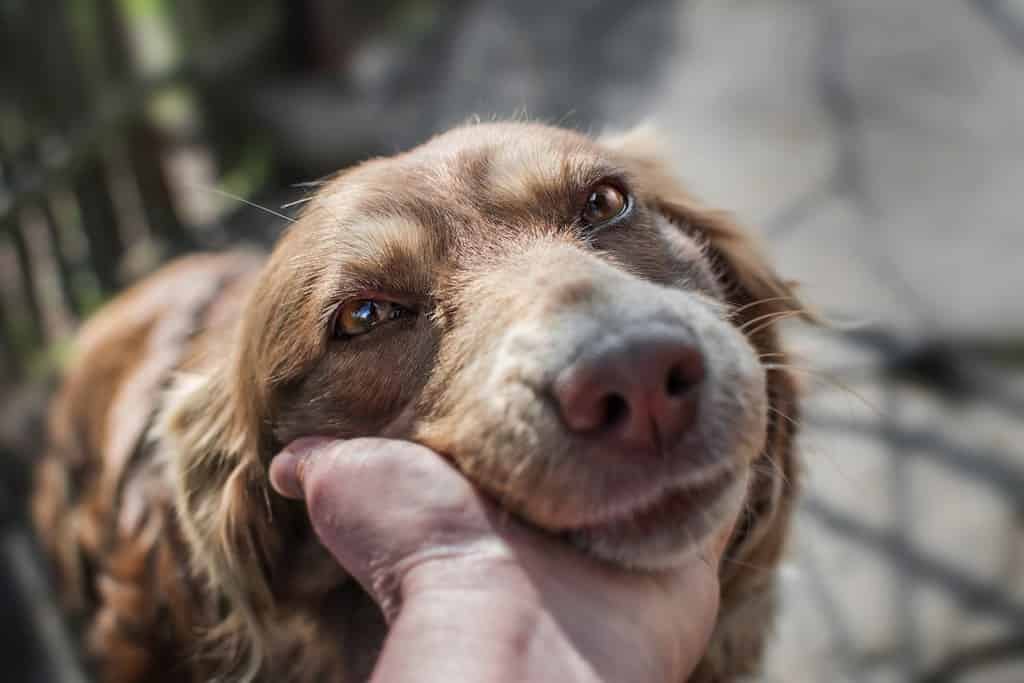
Through science, we’re gaining new insights into how our favorite companions grow older.
©Tanya Kalian/Shutterstock.com
“We’re bringing together dogs, owners, veterinarians, researchers, and volunteers to carry out the world’s most ambitious canine science project,” explains Harmony Diers, Communications Manager of the Dog Aging Project. “Longitudinal studies allow us to connect experiences early in life with health outcomes in old age. We can use this information to investigate how those early events may have directly or indirectly caused late-in-life health issues. The key to success in these endeavors is knowing the full life story of many individual dogs. We keep going because we have so much more to learn and share about the aging process of the companion dogs we love!”
The Dog Aging Project conducts rigorous scientific research designed to define, explain, and ameliorate the effects of aging. To achieve this mission, they have built a community of volunteers and researchers united by a shared love for dogs and committed to helping dogs and humans live longer, healthier lives together.
The Origin Story of the Dog Aging Project
As reported by Diers, in 2007, one of the founders, Dr. Daniel Promislow, had been working on the biology of aging for almost 20 years and running a fruit fly lab at the University of Georgia (UGA) when an issue of Science arrived on his desk. The cover showed a Great Dane and a Chihuahua walking side by side. The paper was about the genetics of size, but it immediately led him to wonder if they could figure out why big dogs (like Great Danes) tend to be much shorter-lived than small dogs (like Chihuahuas). He knew a lot about fruit flies but nothing about the biology of dogs.

An issue of Science magazine featuring a Great Dane and a Chihuahua is reportedly what provided the inspiration for the Dog Aging Project.
©Natallia Yaumenenka/Shutterstock.com
Dr. Promislow then reached out to the UGA College of Veterinary Medicine, and they put him in touch with Dr. Kate Creevy, an early-career veterinary internist. It was immediately apparent to both of them that there were rich parallels between human and canine aging. Taking advantage of the extensive medical and genetic information available about dogs, they began their first project, investigating causes of death among companion dogs. The more they discovered, the more it became clear that studying aging in dogs held powerful potential to advance veterinary medicine and basic aging biology. It also became clear that an extensive, nationwide, long-term study of companion dogs would be the best way to achieve this potential fully.
Meanwhile, on the opposite side of the country, Dr. Matt Kaeberlein was advancing the understanding of the basic biology of aging using biochemical, genetic, and molecular approaches at the University of Washington. In addition to running a busy laboratory, he co-directed the Nathan Shock Center of Excellence in the Basic Biology of Aging and founded the Healthy Aging and Longevity Research Institute at the University of Washington. A dog-lover himself, Dr. Kaeberlein also recognized the rich potential of the companion dog as a partner in aging research.
In 2013, Dr. Promislow moved to Seattle, becoming a professor in the same department as Dr. Kaeberlein at the University of Washington. That same year, Dr. Creevy, Dr. Promislow, and five other colleagues obtained an R24 Network and Infrastructure grant from the NIH National Institute on Aging to develop the plan for a long-term, longitudinal study of aging in companion dogs. The resulting Canine Longevity Consortium hosted three national meetings among invited experts in the field, including Dr. Kaeberlein. Gradually, a plan began taking shape for a longitudinal observational study of dogs, which would include an intervention arm designed to test medicines previously investigated in laboratory species that might improve healthspan (the healthy period of a dog’s life before the signs of aging begin to present) and lifespan in dogs.
Dr. Kaeberlein, Dr. Creevy, and Dr. Promislow deepened their collaboration, building and expanding their shared vision of a nationwide study of aging in companion dogs. In 2014, they founded the Dog Aging Project and began to create a community of dog owners interested in becoming involved in this citizen-science project. In 2015, Dr. Kaeberlein launched the first Dog Aging Project clinical trial, a study to determine the safety and feasibility of testing whether the drug rapamycin can slow aging in pet dogs.
In 2016, Dr. Creevy relocated to Texas A&M University. They continued planning for this ambitious longitudinal study of aging in dogs, with Dr. Promislow as Principal Investigator, Dr. Kaeberlein as Co-Director, and Dr. Creevy as Chief Veterinary Officer. Eventually, they built a team of 20 collaborators nationwide from nine different academic institutions.
In 2018, the Dog Aging Project received U19 grant AG057377 from the National Institute on Aging, a part of the National Institutes of Health, to support the long-term longitudinal study on health and aging in companion dogs.
The Work of the Dog Aging Project

The aim is to help dogs live longer, healthier lives.
©PeopleImages.com – Yuri A/Shutterstock.com
The Dog Aging Project was founded in 2014. In 2018, they received a U19 grant from the NIA to further develop their infrastructure and team and ramped up recruitment of companion dogs and their owners.
“We are excited to say that since our initial recruitment efforts in 2019, we have enrolled over 50,000 dogs across the United States,” says Dier. “Additionally, we have written and published over 70 papers. We couldn’t have made this progress without our participants’ commitment and their incredible volunteerism, as demonstrated through the health surveys and activities they complete for their companions year after year.”
How to Get Involved

Find out how your dog can be involved in the Dog Aging Project.
©iStock.com/iamnoonmai
Dier wants people to know that they are still enrolling dogs for not only their longitudinal, observational study but also a clinical trial, The Test of Rapamycin in Aging Dogs.
The Dog Aging Project (DAP) is an observational, longitudinal study on canine health and aging. The eligibility for this study is:
- Dogs of any size, age, health condition, and lifestyle may be enrolled.
- Currently, over 50,000 dogs are enrolled.
- Dogs remain at home during the study, and their humans answer an annual online survey about their canine companions, participate in optional at-home activities, and submit optional veterinary records.
The Test of Rapamycin in Aging Dogs (TRIAD) is a double-blind clinical trial testing whether the drug rapamycin has an effect on canine healthspan and lifespan in aging dogs. The minimum eligibility for this clinical trial is:
- 7 years of age or older
- 44-120 pounds
- Spayed or neutered
- In overall good health
- TRIAD participants are required to take their dog to a clinical trial site for a veterinary examination every six months for a period of three years.
Conclusion
The Dog Aging Project stands as a testament to the power of collaboration in advancing our understanding of aging in dogs. By leveraging the commitment of dog owners and the expertise of researchers, the Dog Aging Project aims to uncover insights that will not only extend the lives of dogs but also enhance the quality of life for both dogs and their human companions. As the project continues to grow, it represents a significant step forward in the field of veterinary medicine and the study of aging.
This post was originally published on this site be sure to check out more of their content.






























